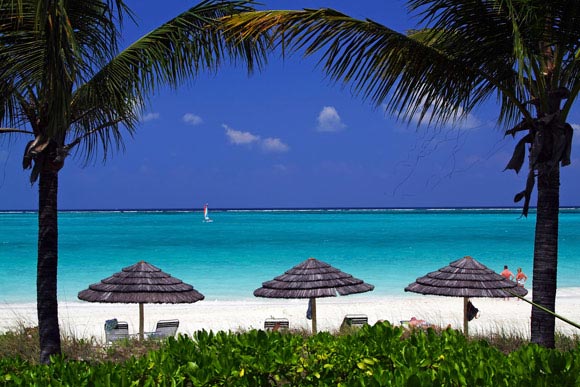From the once voted ‘World’s Best Beach’ to the third largest barrier reef in the world, the Turks and Caicos is not in want of natural attractions. Magnificent stretches of sparkling, white sand, spectacular nature trails, expansive limestone caves and a teeming ecosystem of wildlife are just a handful of what the islands have to offer.
If you are visiting the archipelago for the first time or are looking for inspiration for the next visit, this guide is for you. Here are the top five natural attractions across the Turks and Caicos Islands.

1. Grace Bay
No list of natural attractions in the Turks and Caicos is complete without a mention of one of the world’s most exquisite beaches. Grace Bay offers visitors 8km of unspoiled, shocking white sand, sparkling Caribbean ocean and beautiful coral reef just a short ride from the shoreline.
Many visitors fall so love with Grace Bay that they insist upon staying. Fortunately, the beach is lined with magnificent hotels and resorts that compliment, rather that detract from the tranquillity. There are also beach apartments to rent in the Turks & Caicos Islands if you prefer to stay somewhere more private.
Venture out from the splendid shoreline and you’ll quickly encounter all manner of wildlife and coral reef. The bay is a haven for sun-seekers, sailors and snorkelers alike.
2. Pine Cay
Home to miles of incredible nature trails, beach and rocky outcrops, Pine Cay is an exclusive private island and a must visit for anyone in the Turks and Caicos looking for a total break from reality. The cay’s tranquillity is maintained by a complete ban on televisions and phones making it the perfect place for peaceful relaxation.
Aside from its striking beach, Pine Cay is home to a striking freshwater lens; formed from rainwater held inside porous limestone rock. Off the coast lies a ruined British fort on Fort George Cay, as well as Litter Water Cay, which is home to a rare iguana and a National Trust boardwalk from which visitors can explore.
3. Conch Bar Caves National Park
A magnificent network of underground caverns is protected by the Conch Bar Caves National Park on Middle Caicos; a must visit site for anyone interested in the island’s geography and history. The cave system is the largest of its kind in the Bahamas and was formed some 100,000 years ago. Since then it has been used by Lucayan Indians for shelter and ceremonies and mined for bat guano by 19th century Europeans. Petroglyphs can be found on the walls of the caves, depicting the Lucayans ancient ceremonies.
4. Salt Cay
A UNESCO World Heritage Site and a hotbed for wildlife and coral reef, Salt Cay is one of the most interesting of all the tiny islands in Turks and Caicos. The eclectic mix of wildlife includes iguanas, donkeys and wild cattle; all of which vastly outnumber the local human population. A walk along the coastal paths or a voyage into the sea opens up the possibility of spotting humpback whales during the early part of the year as they migrate to and from the Dominican Republic for birthing.
The cay is also steeped in history, and was once the focal point of the Turks and Caicos economy as it was a world leading producer of salt from as early as the 17th century right through the 1960s.
5. Crossing Trail Place
For spectacular views, intriguing history and numerous interesting features, Crossing Trail Place is a historical path that runs from Middle to North Caicos offering magnificent views of the Mudjin Harbour coastline.
Once upon a time the trail was the primary transport link between the sparsely populated Caicos Islands, allowing travellers to wade between them at low tide. After falling into disuse, it was re-opened by the National Trust in the 1990s and once again weaves through the plantations, close to the coastline of the Mudjin Harbour.
The amazing limestone scenery is what draws visitors to the trail, although you should be warned that you’ll find the path deserted for most of its length. Be sure to take plenty of water and protection from the sun in order to enjoy the plentiful caves and beaches.
